belt VOLKSWAGEN TRANSPORTER 1990 T4 / 4.G User Guide
[x] Cancel search | Manufacturer: VOLKSWAGEN, Model Year: 1990, Model line: TRANSPORTER, Model: VOLKSWAGEN TRANSPORTER 1990 T4 / 4.GPages: 165, PDF Size: 24.87 MB
Page 22 of 165
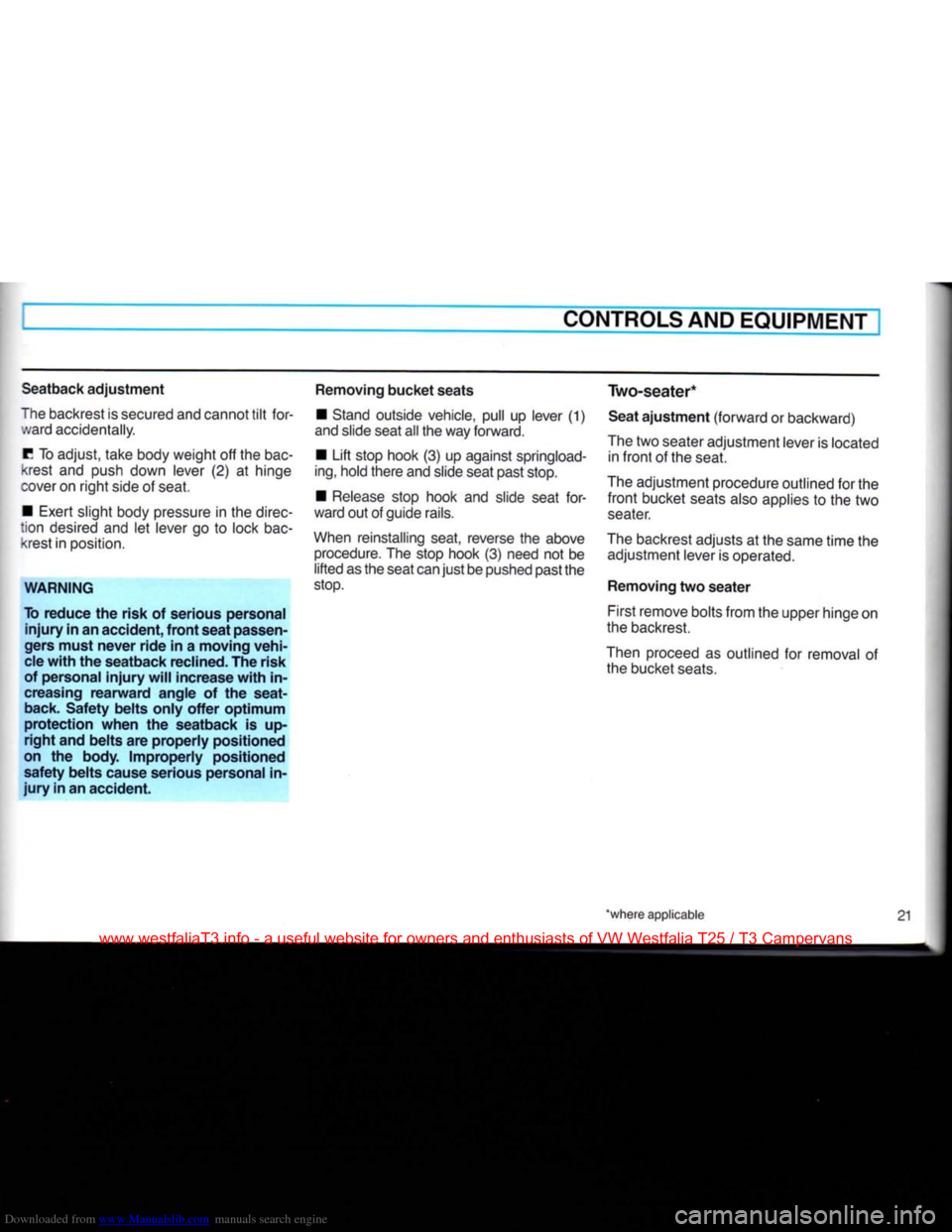
Downloaded from www.Manualslib.com manuals search engine
CONTROLS AND
EQUIPMENT
Seatback
adjustment
The backrest is secured and cannot
tilt
for
ward accidentally.
C
To adjust, take body weight off the
bac
krest and push down lever (2) at hinge
cover on
right
side of seat.
• Exert slight body pressure in the direc
tion
desired and let lever go to lock
bac
krest in position.
WARNING
To
reduce
the
risk
of
serious
personal
injury
in an
accident,
front
seat
passen
gers
must
never
ride
in a
moving
vehi
cle
with
the
seatback
reclined.
The
risk
of
personal
injury
will
increase
with
in
creasing
rearward
angle
of the
seat-
back.
Safety
belts
only
offer
optimum
protection
when
the
seatback
is up
right
and
belts
are
properly
positioned
on the
body.
Improperly
positioned
safety
belts
cause
serious
personal
in
jury
in an
accident.
Removing
bucket
seats
• Stand outside vehicle, pull up lever (1)
and slide seat all the way forward.
•
Lift
stop hook (3) up against springload-
ing,
hold there and slide seat past stop.
•
Release
stop hook and slide seat
for
ward out of guide rails.
When reinstalling seat, reverse the above procedure. The stop hook (3) need not be
lifted
as the seat can
just
be pushed past the
stop.
Two-seater*
Seat
ajustment
(forward
or backward)
The two seater adjustment lever is located in
front
of the seat.
The adjustment procedure outlined for the
front
bucket seats also applies to the two
seater.
The backrest adjusts at the same
time
the adjustment lever is operated.
Removing
two
seater
First remove bolts
from
the upper hinge on
the backrest.
Then proceed as outlined for removal of the bucket
seats.
*where applicable 21
www.westfaliaT3.info - a useful website for owners and enthusiasts of VW Westfalia T25 / T3 Campervans
Page 27 of 165
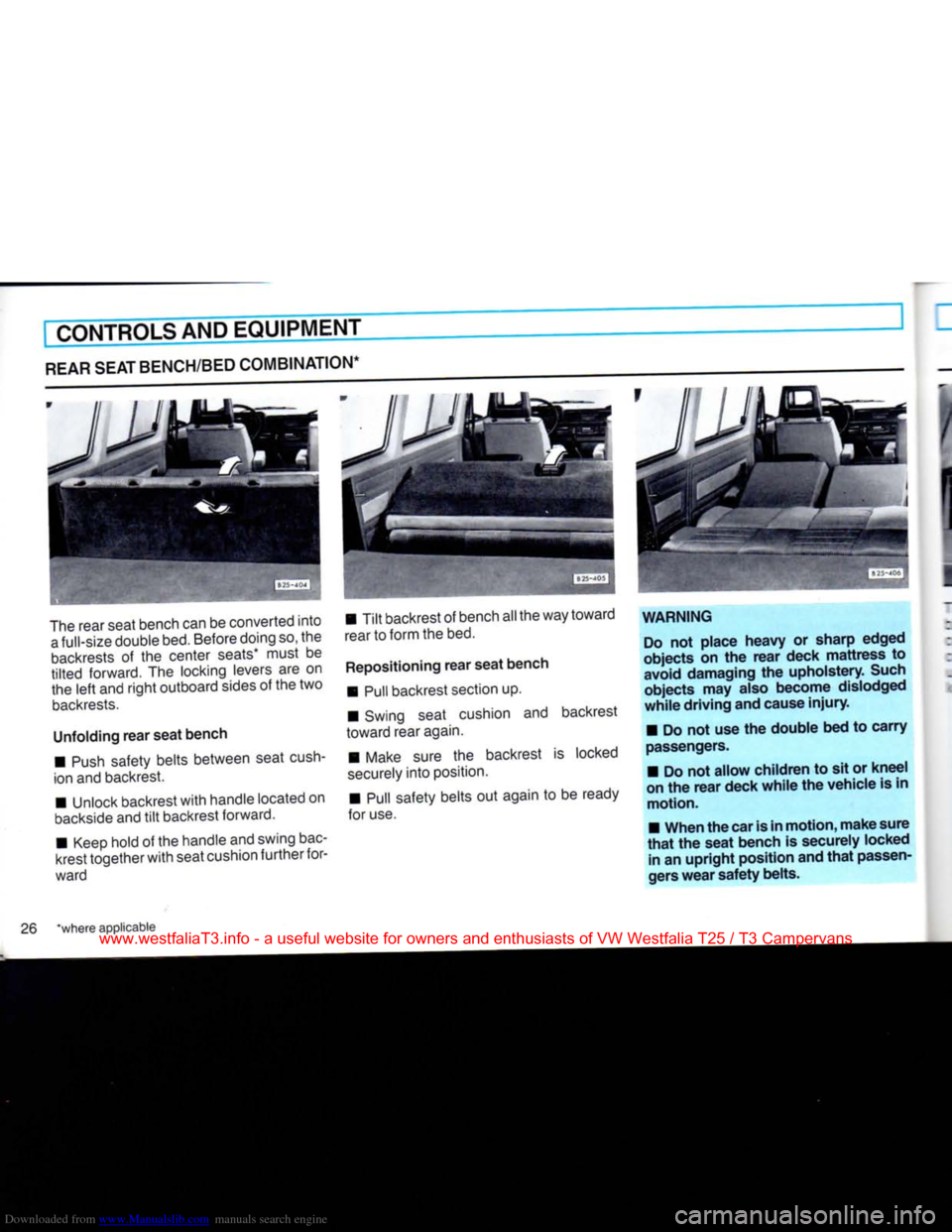
Downloaded from www.Manualslib.com manuals search engine
CONTROLS AND
EQUIPMENT
REAR SEAT BENCH/BED
COMBINATION*
The rear seat bench can be converted
into
a
full-size double bed. Before doing so, the
backrests
of the center seats* must be
tilted
forward. The locking levers are on
the
left
and
right
outboard sides of the two
backrests.
Unfolding
rear
seat
bench •
Push
safety belts between seat
cush
ion and backrest.
• Unlock backrest
with
handle located on
backside
and
tilt
backrest forward.
• Keep hold of the handle and swing bac
krest together
with
seat cushion
further
for
ward •
Tilt
backrest of bench all the way toward
rear to form the bed.
Repositioning
rear
seat
bench • Pull backrest section up.
• Swing seat cushion and backrest
toward rear again.
• Make sure the backrest is locked
securely
into
position.
• Pull safety belts out again to be ready
for use.
WARNING
Do not
place
heavy
or
sharp
edged
objects
on the
rear
deck
mattress
to
avoid
damaging
the
upholstery.
Such
objects
may also
become
dislodged
while
driving
and cause
injury.
• Do not use the
double
bed to
carry
passengers.
• Do not
allow
children
to sit or
kneel
on the
rear
deck
while
the
vehicle
is in
motion.
•
When
the car is in
motion,
make
sure
that
the
seat
bench is securely locked in an
upright
position
and
that
passen
gers
wear
safety
belts.
26 *where applicable
www.westfaliaT3.info - a useful website for owners and enthusiasts of VW Westfalia T25 / T3 Campervans
Page 29 of 165
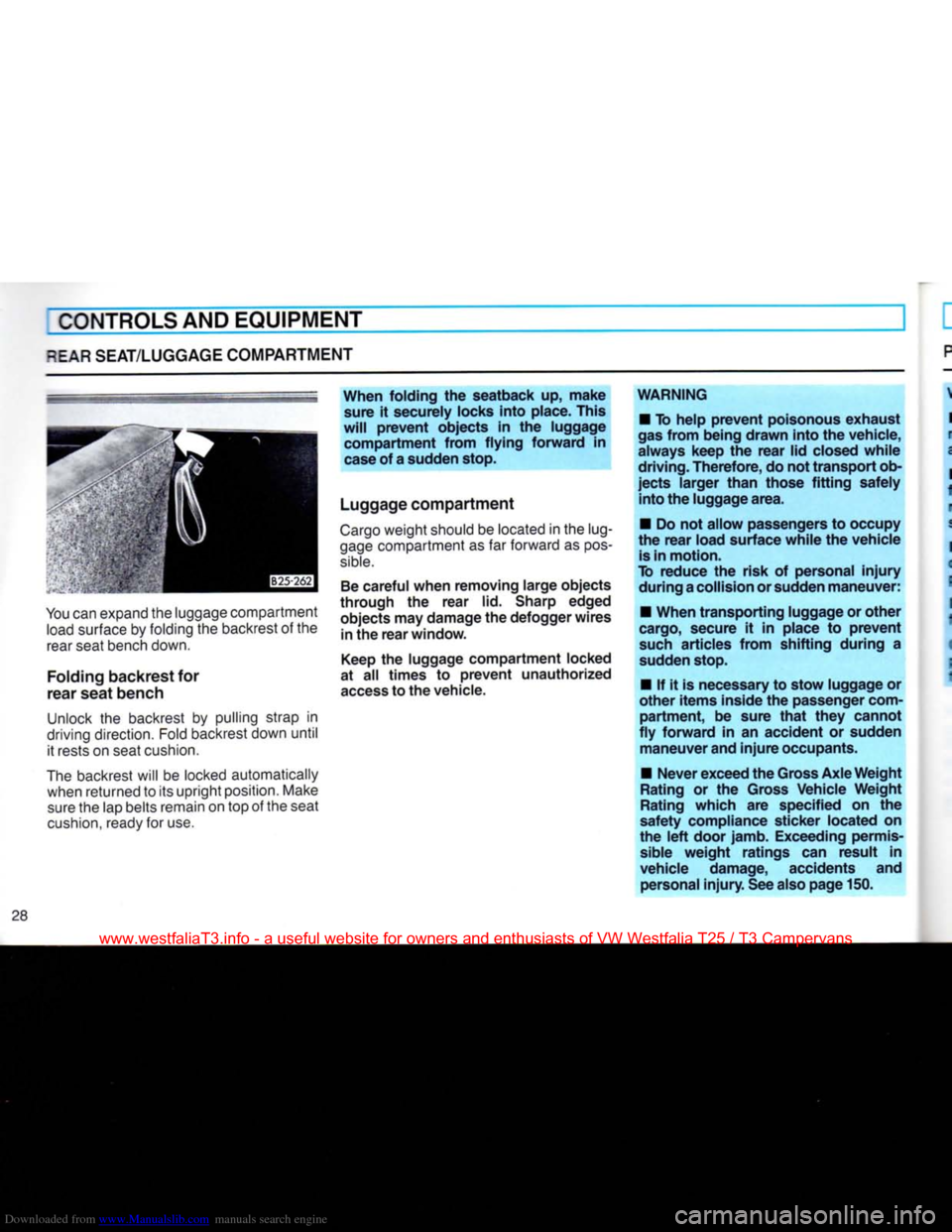
Downloaded from www.Manualslib.com manuals search engine
CONTROLS
AND
EQUIPMENT
^EAR SEAT/LUGGAGE COMPARTMENT
You can expand the luggage compartment
load
surface
by
folding
the
backrest
of the
rear seat bench down.
Folding
backrest for
rear seat bench
Unlock
the
backrest
by
pulling strap
in
driving direction. Fold backrest down until it rests
on
seat cushion.
The backrest will
be
locked automatically when returned
to
its upright position. Make sure the lap belts remain
on
top
of
the seat
cushion,
ready
for
use. When folding
the
seatback
up,
make
sure
it
securely locks into place.
This
will
prevent
objects
in the
luggage compartment from flying forward
in
case
of
a
sudden stop.
Luggage compartment
Cargo weight should
be
located
in the
lug
gage compartment
as far
forward
as
pos
sible.
Be
careful when removing large objects
through
the
rear
lid.
Sharp edged objects may damage the defogger wires in the rear window.
Keep
the
luggage compartment locked
at
all
times
to
prevent
unauthorized
access
to the vehicle. WARNING
•
To
help
prevent
poisonous exhaust
gas from being drawn into the vehicle,
always keep
the
rear lid closed while
driving. Therefore, do not transport ob
jects larger than those fitting safely into the luggage
area.
•
Do
not allow passengers to occupy
the rear load surface while the vehicle
is
in motion.
To reduce
the
risk
of
personal
injury
during
a
collision
or sudden maneuver:
•
When transporting luggage or other
cargo, secure
it in
place
to
prevent
such articles from shifting during
a
sudden stop.
•
If it is
necessary to stow luggage
or
other items inside the passenger
com
partment,
be
sure that
they
cannot
fly forward
in an
accident
or
sudden maneuver
and
injure occupants.
•
Never
exceed the Gross Axle Weight
Rating
or the
Gross Vehicle Weight
Rating
which
are
specified
on the
safety compliance sticker located
on
the left door jamb. Exceeding permis
sible
weight ratings
can
result
in
vehicle damage, accidents
and
personal
injury.
See also page
150.
www.westfaliaT3.info - a useful website for owners and enthusiasts of VW Westfalia T25 / T3 Campervans
Page 40 of 165
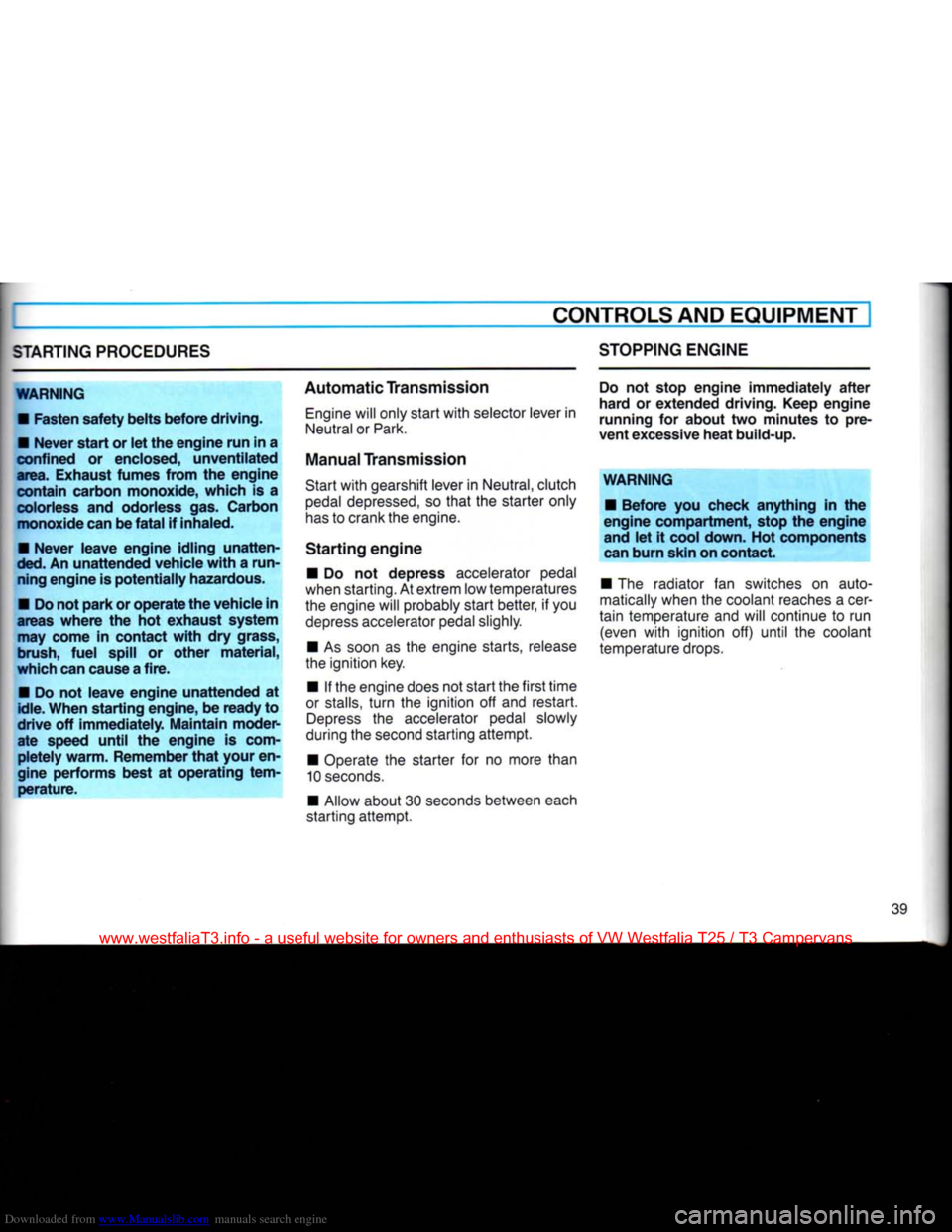
Downloaded from www.Manualslib.com manuals search engine
CONTROLS
AND
EQUIPMENT
STARTING
PROCEDURES
WARNING
•
Fasten safety belts before driving.
•
Never
start or let the engine run in a
confined or enclosed, unventilated
area.
Exhaust fumes from the engine
contain carbon monoxide, which is a
colorless
and odorless gas. Carbon monoxide can be
fatal
if inhaled.
•
Never
leave engine idling unatten
ded.
An unattended vehicle with a run
ning
engine is potentially hazardous.
•
Do not park or operate the vehicle in
areas
where the hot exhaust system may come in contact with dry grass,
brush,
fuel
spill
or other
material,
which can cause a fire.
•
Do not leave engine unattended at
idle.
When starting engine, be ready to
drive off immediately. Maintain moder
ate
speed until the engine is
com
pletely warm. Remember that
your
en
gine performs best at operating
tem
perature.
Automatic
Transmission
Engine will only start with selector lever in
Neutral or Park.
Manual
Transmission
Start with gearshift lever in Neutral, clutch
pedal
depressed, so that the starter only
has
to crank the engine.
Starting
engine
•
Do not depress accelerator pedal
when starting. At extrem low temperatures
the engine will probably start better, if you depress accelerator pedal slighly.
•
As soon as the engine starts, release
the ignition key.
•
If the engine does not start the first time
or
stalls,
turn
the ignition off and restart. Depress the accelerator pedal slowly
during the second starting attempt.
•
Operate the starter for no more than
10
seconds.
•
Allow about 30 seconds between each
starting
attempt.
STOPPING
ENGINE
Do not stop engine immediately after
hard or extended driving. Keep engine
running for about two minutes to pre
vent
excessive heat build-up.
WARNING
•
Before you check anything in the
engine compartment, stop the engine and let it cool down. Hot components
can
burn skin on contact.
•
The radiator fan switches on auto
matically
when the coolant reaches a cer
tain
temperature and will continue to run
(even
with ignition off) until the coolant
temperature drops.
39
www.westfaliaT3.info - a useful website for owners and enthusiasts of VW Westfalia T25 / T3 Campervans
Page 43 of 165
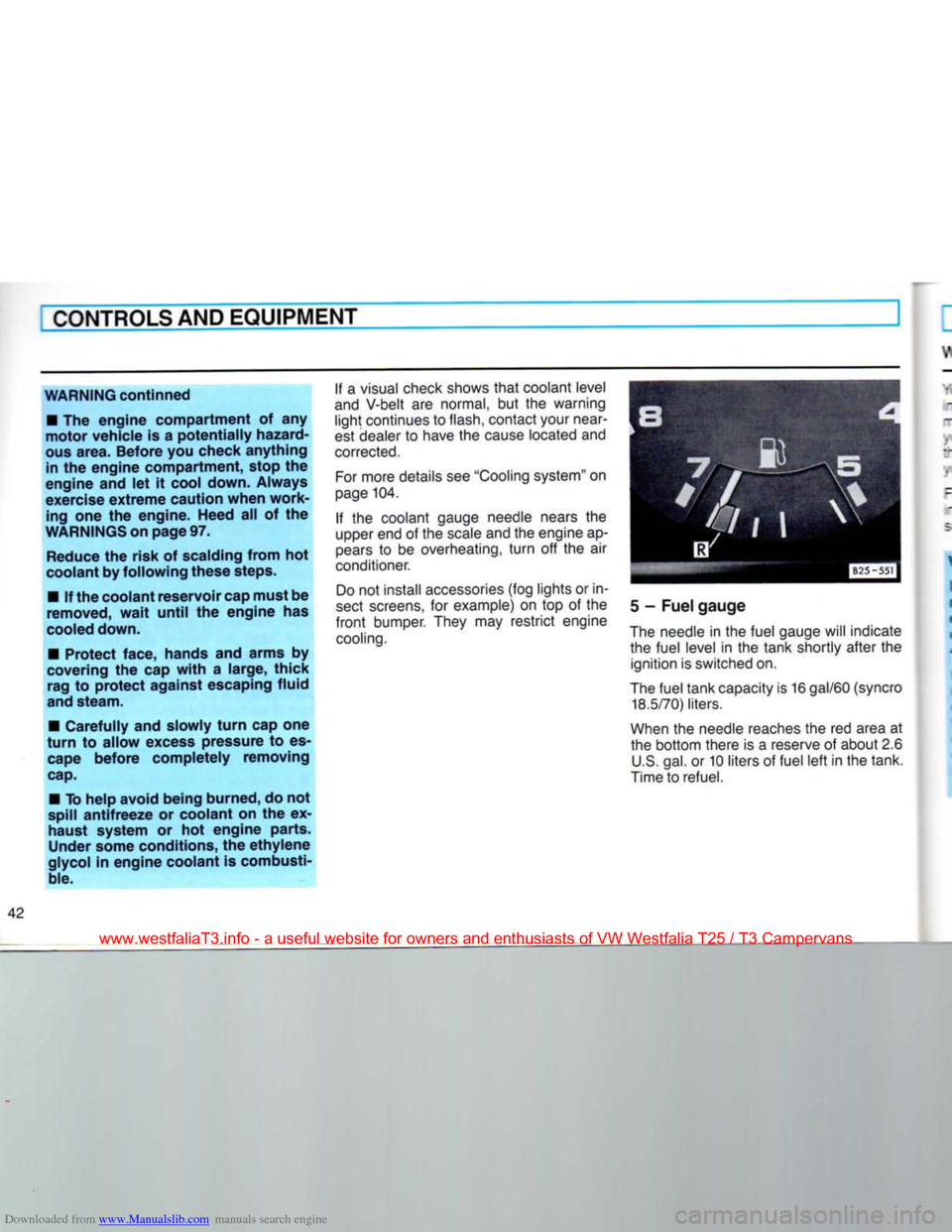
Downloaded from www.Manualslib.com manuals search engine
CONTROLS
AND
EQUIPMENT
WARNING continned •
The
engine compartment
of any
motor vehicle
is a
potentially hazard
ous
area.
Before you check anything in the engine compartment, stop
the
engine and
let it
cool down. Always
exercise extreme caution when work
ing
one the
engine. Heed
all of the
WARNINGS on page
97.
Reduce the risk
of
scalding from
hot
coolant by following these steps.
• If the coolant reservoir cap must be
removed, wait until
the
engine
has
cooled down.
• Protect face, hands
and
arms
by
covering
the cap
with
a
large, thick
rag
to
protect against escaping fluid
and
steam.
• Carefully and slowly
turn
cap
one
turn
to
allow excess pressure
to es
cape before completely removing
cap.
•
To
help avoid being burned,
do not
spill
antifreeze
or
coolant
on the ex
haust system
or hot
engine parts.
Under
some conditions, the ethylene
glycol
in
engine coolant
is
combusti
ble.
If a
visual check shows that coolant level
and V-belt
are
normal,
but the
warning light continues to
flash,
contact
your
near
est dealer
to
have
the
cause located
and
corrected.
For more details see "Cooling system"
on
page 104.
If the
coolant gauge needle nears
the
upper end
of
the scale and the engine ap
pears
to be
overheating,
turn
off the air
conditioner.
Do
not
install accessories
(fog
lights
or
in
sect screens,
for
example)
on top of the
front
bumper.
They
may
restrict engine
cooling.
5
-
Fuel gauge
The needle
in
the fuel gauge will indicate the fuel level
in the
tank shortly after
the
ignition is switched on.
The fuel tank capacity is
16
gal/60
(syncro
18.5/70)
liters.
When
the
needle reaches the
red
area
at
the bottom there
is a
reserve
of
about 2.6 U.S. gal.
or
10 liters
of
fuel left in the tank.
Time to refuel.
www.westfaliaT3.info - a useful website for owners and enthusiasts of VW Westfalia T25 / T3 Campervans
Page 44 of 165
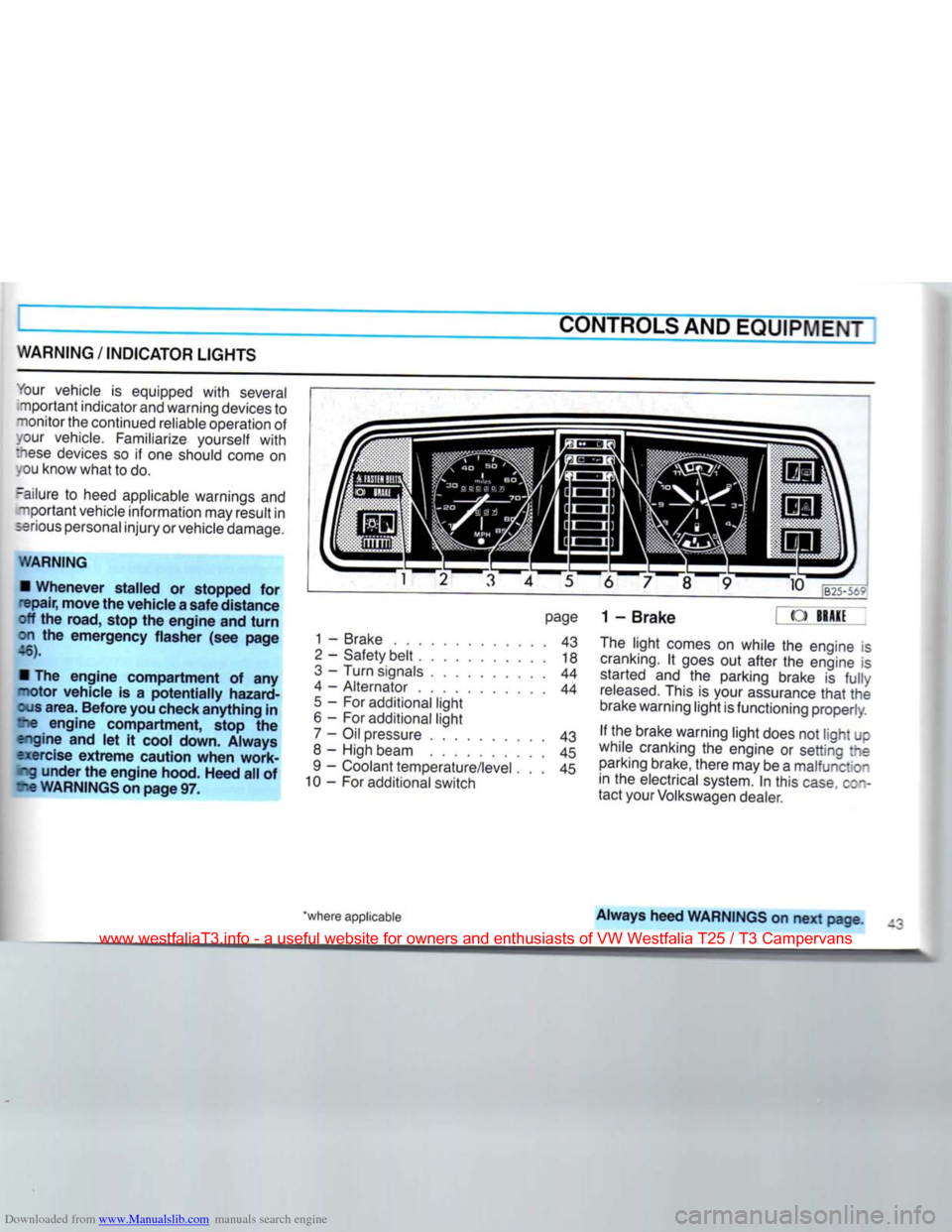
Downloaded from www.Manualslib.com manuals search engine
CONTROLS
AND
EQUIPMENT
WARNING
/ INDICATOR
LIGHTS
1 2 3 4 5 6 7 8
your vehicle is equipped
with
several
•nportant indicator and warning devices to
~ionitor the continued reliable operation of .our vehicle. Familiarize yourself
with
:hese
devices so if one should come on .ou know what to do.
-allure to heed applicable warnings and "nportant vehicle information may result in
serious
personal injury or vehicle damage.
WARNING
•
Whenever
stalled
or stopped for
epair,
move
the
vehicle
a
safe
distance
off the road, stop the
engine
and
turn
on the
emergency
flasher
(see
page
46).
• The
engine
compartment
of any
-lotor
vehicle
is a
potentially
hazard
ous
area.
Before
you check
anything
in
?ie
engine
compartment,
stop the
engine
and let it cool down.
Always
exercise
extreme
caution
when
work
ing
under
the
engine
hood.
Heed
all of
re
WARNINGS
on
page
97.
page
1 - Brake 43
2
- Safety belt 18
3
- Turn signals 44
4 - Alternator 44
5
- For additional light
6 - For additional light 7 - Oil pressure 43
8 - High beam 45
9 - Coolant temperature/level . . . 45
10 - For additional switch 9 10
B25-5t?
1-Brake
« ->
The
light comes on while the engine is
cranking.
It goes out after the engine is started and the parking brake is
fully
released.
This is your assurance
that
the
brake warning light is functioning properly.
If the brake warning light does not light JC
while cranking the engine or setting :ne parking brake, there may be a malfunction in the electrical system. In this
case
c;~-
tact your Volkswagen dealer.
'where applicable
Always
heed
WARNINGS
on next page
www.westfaliaT3.info - a useful website for owners and enthusiasts of VW Westfalia T25 / T3 Campervans
Page 45 of 165
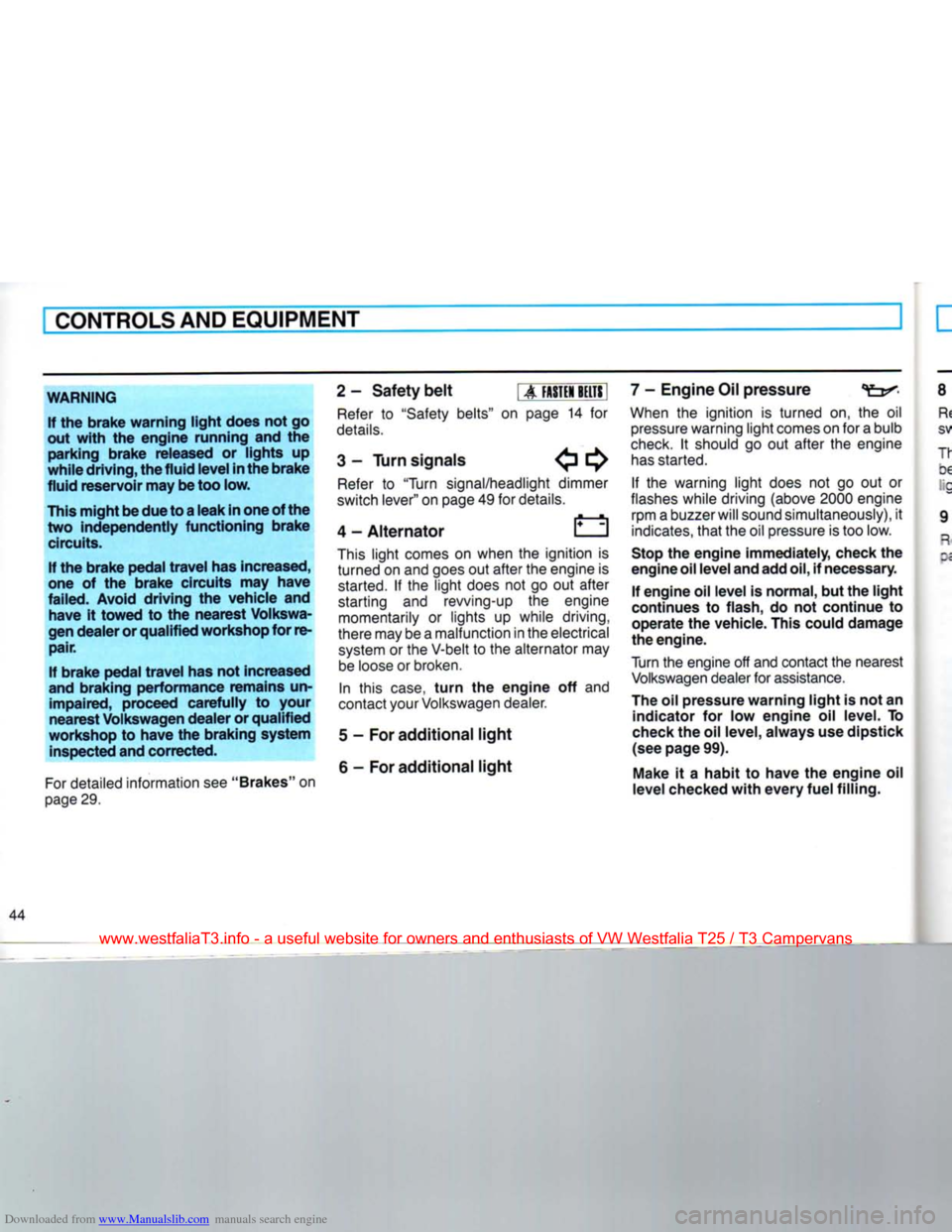
Downloaded from www.Manualslib.com manuals search engine
I CONTROLSAND EQUIPMENT
WARNING If the brake warning
light
does not go
out
with
the engine running and the parking brake released or lights up
while driving, the fluid level
in
the brake
fluid reservoir may
be
too low.
This might be
due
to
a
leak in one of the two independently functioning brake circuits.
If the brake pedal travel has increased,
one of the brake circuits may have
failed.
Avoid driving the vehicle and have it towed to the nearest Volkswa
gen dealer or qualified workshop for re pair.
If brake pedal travel has not increased
and
braking performance remains un
impaired,
proceed carefully to
your
nearest Volkswagen dealer or qualified
workshop to have the braking system inspected and corrected.
For detailed information see
"Brakes" on
page 29. 2-
Safety belt
|
A
FASTEN
BELTS
Refer
to
"Safety belts"
on
page
14 for
details.
3
-
Turn
signals E^
Refer
to
"Turn
signal/headlight dimmer
switch lever" on page 49 for details.
4
- Alternator
This
light comes
on
when
the
ignition
is
turned on and goes out after the engine
is
started.
If the
light does
not go out
after
starting
and
revving-up
the
engine
momentarily
or
lights
up
while driving,
there may be a malfunction
in
the electrical system
or
the V-belt
to
the alternator may be loose
or
broken.
In
this
case,
turn
the engine off and
contact
your
Volkswagen dealer.
5
- For additional
light
6
- For additional
light
7
- Engine Oil pressure
When
the
ignition
is
turned
on, the oil
pressure warning light comes on for a bulb
check.
It
should
go out
after
the
engine
has
started.
If the
warning light does
not go out or
flashes
while driving
(above
2000
engine rpm a buzzer
will
sound simultaneously),
it
indicates,
that the oil pressure is too low.
Stop the engine immediately, check the
engine
oil
level
and add
oil, if necessary.
If engine oil level is normal, but the
light
continues to flash, do not continue to
operate the vehicle. This could damage
the engine.
Turn
the engine off and contact the nearest Volkswagen dealer for assistance.
The oil pressure warning
light
is not an indicator for low engine oil level. To
check
the oil level, always use dipstick
(see page 99).
Make
it a habit to have the engine oil
level checked
with
every
fuel filling.
www.westfaliaT3.info - a useful website for owners and enthusiasts of VW Westfalia T25 / T3 Campervans
Page 72 of 165
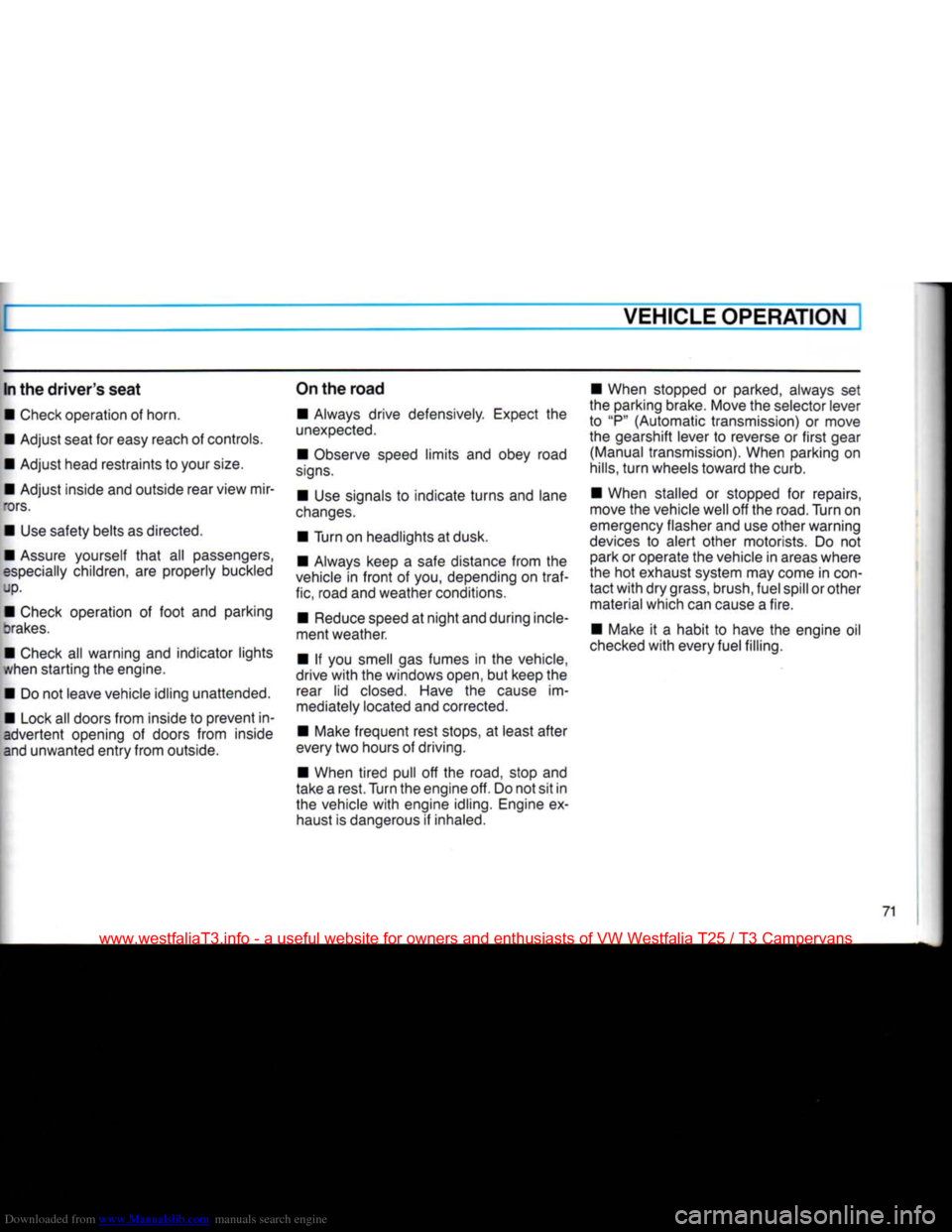
Downloaded from www.Manualslib.com manuals search engine
VEHICLE
OPERATION
In the
driver's
seat
•
Check operation of horn.
•
Adjust seat for easy reach of controls.
•
Adjust head restraints to your
size.
•
Adjust inside and outside rear view mir-
brs.
•
Use safety belts as directed.
•
Assure yourself
that
all passengers,
especially
children, are properly buckled up.
•
Check operation of
foot
and parking
orakes.
•
Check all warning and indicator lights
v/hen starting the engine.
•
Do not leave vehicle idling unattended.
•
Lock all doors
from
inside to prevent in advertent opening of doors
from
inside
and unwanted
entry
from
outside. On the
road
•
Always drive defensively. Expect the
unexpected.
•
Observe speed
limits
and obey road
signs.
•
Use signals to indicate
turns
and lane
changes.
•
Turn on headlights at dusk.
•
Always keep a safe distance
from
the
vehicle in
front
of you, depending on
traf
fic, road and weather conditions.
•
Reduce speed at
night
and during incle
ment weather.
•
If you smell gas fumes in the vehicle,
drive
with
the windows open, but keep the rear lid
closed.
Have the cause im
mediately located and corrected.
•
Make frequent rest stops, at least
after
every two hours of driving.
•
When
tired
pull off the road, stop and
take a rest. Turn the engine off. Do not sit in the vehicle
with
engine idling. Engine exhaust is dangerous if inhaled.
•
When stopped or parked, always set
the parking brake. Move the selector lever
to "P" (Automatic transmission) or move
the gearshift lever to reverse or
first
gear (Manual transmission). When parking on
hills,
turn
wheels
toward
the curb.
•
When stalled or stopped for repairs,
move the vehicle well off the road. Turn on
emergency flasher and use other warning
devices
to alert other motorists. Do not park or operate the vehicle in areas where
the hot exhaust system may come in
con
tact
with
dry
grass,
brush, fuel spill or other material which can cause a fire.
•
Make it a habit to have the engine oil
checked
with
every fuel filling.
www.westfaliaT3.info - a useful website for owners and enthusiasts of VW Westfalia T25 / T3 Campervans
Page 80 of 165
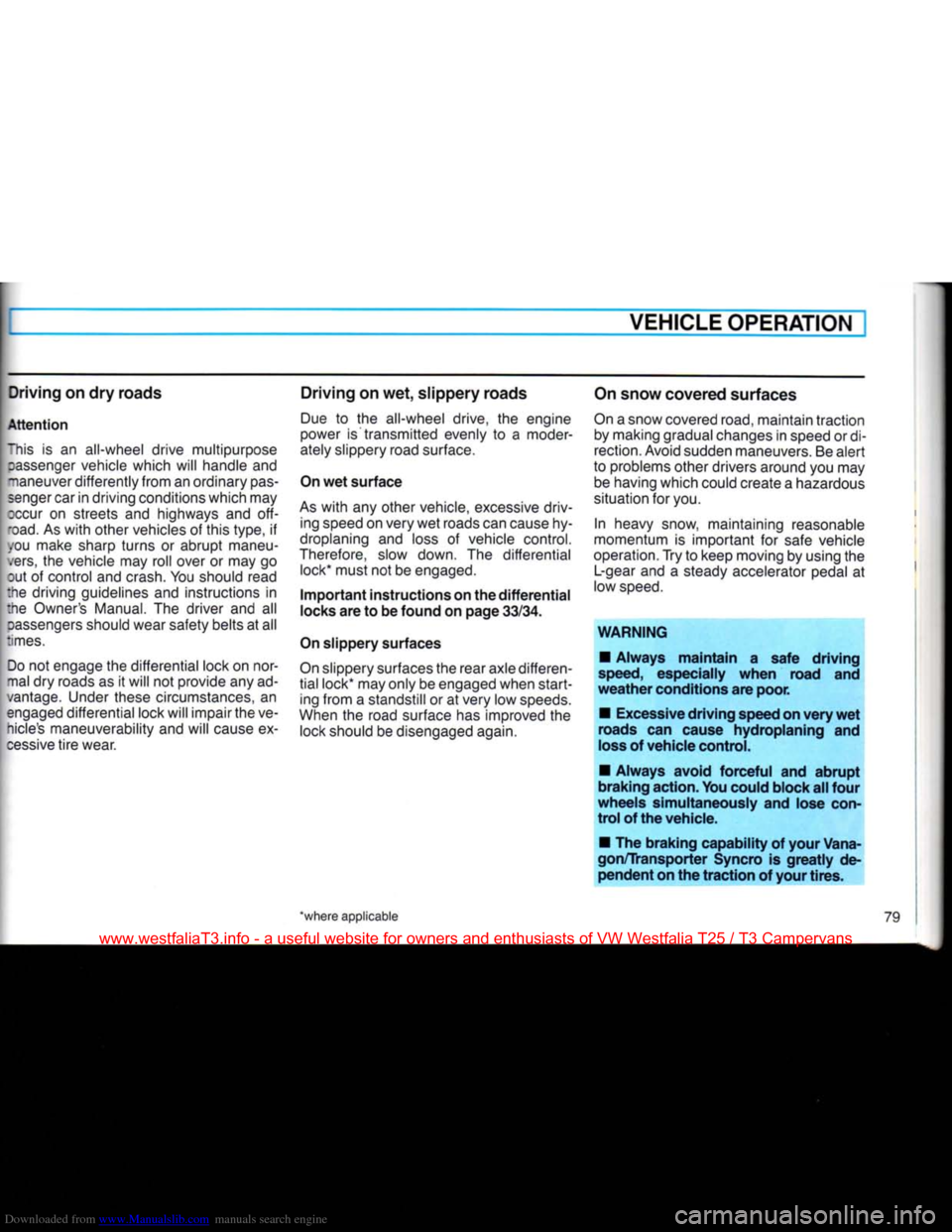
Downloaded from www.Manualslib.com manuals search engine
-
VEHICLE
OPERATION
Driving on dry roads
Attention
"his
is an
all-wheel drive multipurpose
rassenger
vehicle which
will
handle
and
maneuver
differently
from
an ordinary
pas
senger
car in driving conditions which may
occur
on
streets
and
highways
and off-
'oad.
As
with
other vehicles
of
this type,
if
you make sharp turns
or
abrupt maneu
vers,
the
vehicle
may
roll over
or
may
go
kit
of
control and
crash.
You should read
:he driving guidelines
and
instructions
in
the Owner's
Manual.
The
driver
and all
oassengers
should wear safety belts
at all
times.
Do
not
engage
the
differential lock on nor
mal
dry
roads
as it
will
not
provide any ad
vantage. Under these circumstances,
an
engaged differential lock
will
impair the ve-
nicle's
maneuverability and
will
cause
ex
cessive
tire
wear.
Driving on wet, slippery roads
Due
to the
all-wheel drive,
the
engine
power
is
transmitted evenly
to a
moder
ately slippery road surface.
On
wet surface
As
with
any
other vehicle, excessive driv ing speed on very wet roads can cause hy
droplaning
and
loss
of
vehicle control.
Therefore, slow down.
The
differential lock* must
not be
engaged.
Important
instructions
on
the
differential
locks
are to be found on page
33/34.
On
slippery surfaces
On
slippery surfaces the rear axle differen
tial
lock may only be engaged when
start
ing
from
a
standstill
or at
very low
speeds.
When
the
road surface has improved
the
lock should
be
disengaged again. On
snow covered surfaces
On
a
snow covered road, maintain traction by making gradual changes
in
speed
or
di
rection. Avoid sudden maneuvers. Be alert
to problems other drivers around you may be having which could create
a
hazardous
situation
for
you.
In heavy snow, maintaining reasonable
momentum
is
important
for
safe vehicle
operation. Try
to
keep moving
by
using
the
L-gear and
a
steady accelerator pedal
at
low
speed.
WARNING
•
Always
maintain
a safe driving
speed,
especially
when
road and
weather
conditions are poor.
•
Excessive
driving speed on very wet
roads can cause hydroplaning and
loss
of vehicle control.
•
Always avoid forceful and
abrupt
braking action.
You
could block all four
wheels simultaneously and lose
con
trol
of the vehicle.
•
The braking capability of your Vana-
gon/Transporter Syncro is
greatly
de
pendent on the
traction
of your tires.
'where applicable 79
www.westfaliaT3.info - a useful website for owners and enthusiasts of VW Westfalia T25 / T3 Campervans
Page 81 of 165
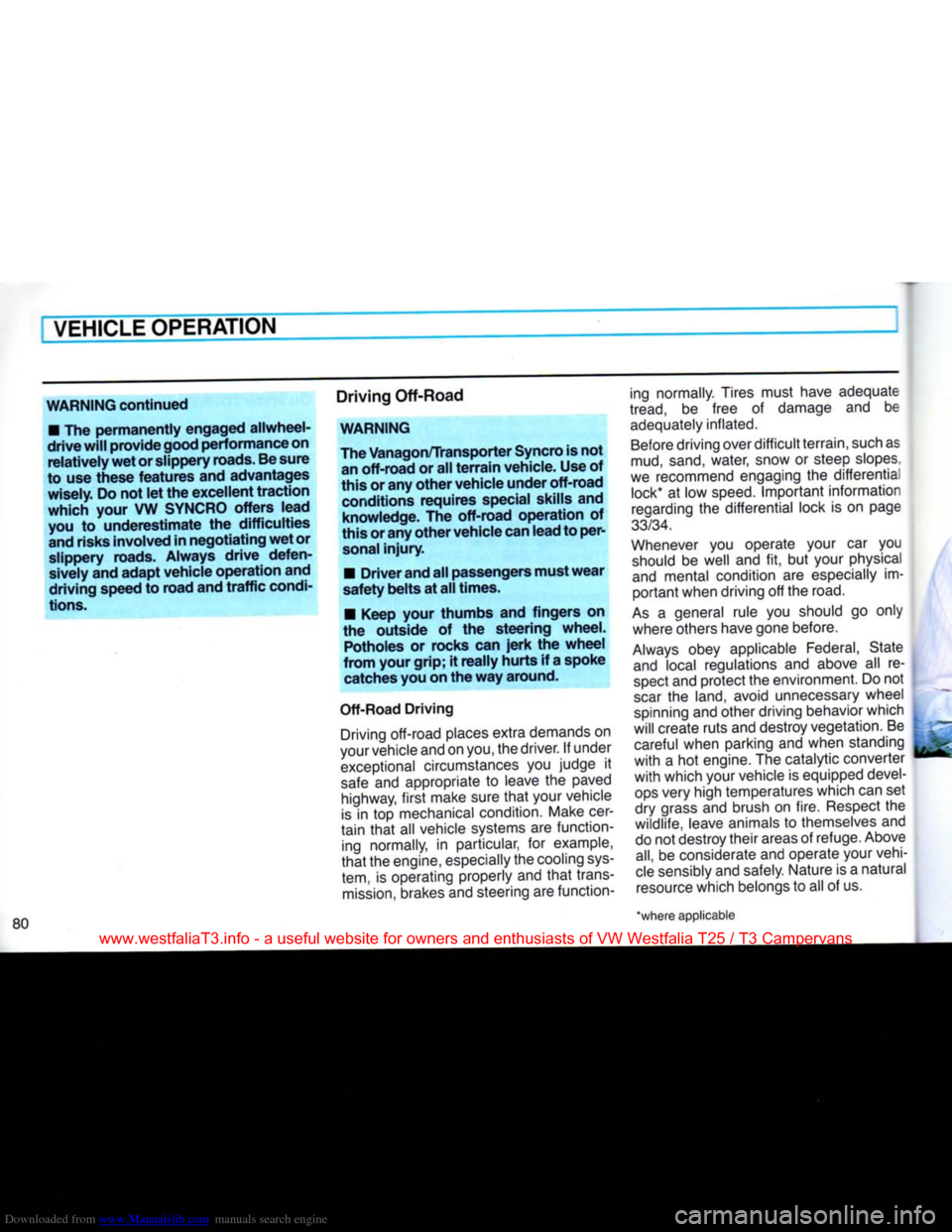
Downloaded from www.Manualslib.com manuals search engine
VEHICLE
OPERATION
WARNING continued
•
The permanently engaged allwheel-
drive
will
provide
good
performance on relatively wet or slippery
roads.
Be
sure
to use these features and advantages
wisely. Do not let the excellent traction
which your VW
SYNCRO
offers lead
you
to underestimate the difficulties
and risks involved in negotiating wet or
slippery
roads. Always drive defen
sively
and adapt vehicle operation and
driving speed to road and
traffic
condi
tions.
Driving Off-Road
WARNING
The Vanagon/Transporter
Syncro
is not an off-road or all
terrain
vehicle. Use of
this or any other vehicle under off-road
conditions
requires special skills and knowledge. The off-road operation of
this or any other
vehicle
can
lead
to per
sonal
injury.
•
Driver and all
passengers
must
wear
safety belts at all times.
•
Keep your thumbs and fingers on
the outside of the steering wheel.
Potholes
or rocks can
jerk
the
wheel
from your grip; it really hurts if a spoke
catches
you on the way around.
Off-Road
Driving
Driving off-road places extra demands
on
your vehicle and on you, the driver.
If
under
exceptional
circumstances
you
judge
it
safe
and
appropriate
to
leave
the
paved highway,
first
make sure
that
your vehicle
is
in top
mechanical condition. Make cer
tain
that
all
vehicle systems
are
function ing normally,
in
particular,
for
example,
that
the engine, especially the cooling
sys
tem,
is
operating properly and
that
trans
mission,
brakes and steering are function ing normally. Tires must have adequate
tread,
be
free
of
damage
and be
adequately inflated.
Before
driving over
difficult
terrain, such as
mud,
sand,
water, snow
or
steep
slopes,
we recommend engaging
the
differentia lock*
at low
speed.
Important
information
regarding
the
differential lock
is on
page
33/34.
Whenever
you
operate your
car you
should
be
well
and fit, but
your physical
and
mental condition
are
especially
im
portant
when driving
off
the road.
As
a
general rule
you
should
go
only where others have gone before.
Always
obey applicable
Federal,
State
and
local regulations
and
above
all re
spect
and protect the environment. Do
not
scar
the
land, avoid unnecessary wheel
spinning and other driving behavior which
will
create
ruts
and destroy vegetation.
Be
careful when parking and when standing
with
a hot
engine. The catalytic converter
with
which your vehicle
is
equipped devel
ops
very high temperatures which can set
dry grass and brush
on
fire. Respect
the
wildlife, leave animals
to
themselves
and
do not destroy their areas
of
refuge. Above
all,
be
considerate and operate your vehi
cle
sensibly and safely. Nature
is a
natural
resource
which belongs
to
all
of
us.
'where applicable
www.westfaliaT3.info - a useful website for owners and enthusiasts of VW Westfalia T25 / T3 Campervans